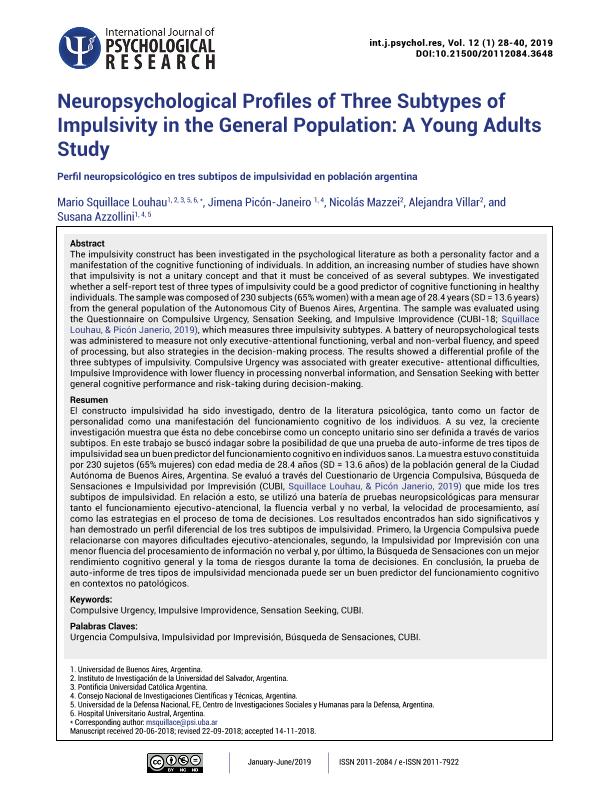Artículo
The impulsivity construct has been investigated in the psychological literature as both a personality factor and a manifestation of the cognitive functioning of individuals. In addition, an increasing number of studies have shown that impulsivity is not a unitary concept and that it must be conceived of as several subtypes. We investigated whether a self-report test of three types of impulsivity could be a good predictor of cognitive functioning in healthy individuals. The sample was composed of 230 subjects (65% women) with a mean age of 28.4 years (SD = 13.6 years) from the general population of the Autonomous City of Buenos Aires, Argentina. The sample was evaluated using the Questionnaire on Compulsive Urgency, Sensation Seeking, and Impulsive Improvidence (CUBI-18; Squillace Louhau, & Picón Janerio, 2019), which measures three impulsivity subtypes. A battery of neuropsychological tests was administered to measure not only executive-attentional functioning, verbal and non-verbal fluency, and speed of processing, but also strategies in the decision-making process. The results showed a differential profile of the three subtypes of impulsivity. Compulsive Urgency was associated with greater executive- attentional difficulties, Impulsive Improvidence with lower fluency in processing nonverbal information, and Sensation Seeking with better general cognitive performance and risk-taking during decision-making. El constructo impulsividad ha sido investigado, dentro de la literatura psicológica, tanto como un factor de personalidad como una manifestación del funcionamiento cognitivo de los individuos. A su vez, la creciente investigación muestra que ésta no debe concebirse como un concepto unitario sino ser definida a través de varios subtipos. En este trabajo se buscó indagar sobre la posibilidad de que una prueba de auto-informe de tres tipos de impulsividad sea un buen predictor del funcionamiento cognitivo en individuos sanos. La muestra estuvo constituida por 230 sujetos (65% mujeres) con edad media de 28.4 años (SD = 13.6 años) de la población general de la Ciudad Autónoma de Buenos Aires, Argentina. Se evaluó a través del Cuestionario de Urgencia Compulsiva, Búsqueda de Sensaciones e Impulsividad por Imprevisión (CUBI, Squillace Louhau, & Picón Janerio, 2019) que mide los tres subtipos de impulsividad. En relación a esto, se utilizó una batería de pruebas neuropsicológicas para mensurar tanto el funcionamiento ejecutivo-atencional, la fluencia verbal y no verbal, la velocidad de procesamiento, así como las estrategias en el proceso de toma de decisiones. Los resultados encontrados han sido significativos y han demostrado un perfil diferencial de los tres subtipos de impulsividad. Primero, la Urgencia Compulsiva puede relacionarse con mayores dificultades ejecutivo-atencionales, segundo, la Impulsividad por Imprevisión con una menor fluencia del procesamiento de información no verbal y, por último, la Búsqueda de Sensaciones con un mejor rendimiento cognitivo general y la toma de riesgos durante la toma de decisiones. En conclusión, la prueba de auto-informe de tres tipos de impulsividad mencionada puede ser un buen predictor del funcionamiento cognitivo en contextos no patológicos.
Neuropsychological profiles of three subtypes of impulsivity in the general population: A young adults study
Louhau, Mario Squillace; Picón Janeiro, Jimena Cristina ; Mazzei, Nicolás; Villar, Alejandra; Azzollini, Susana Celeste
; Mazzei, Nicolás; Villar, Alejandra; Azzollini, Susana Celeste
 ; Mazzei, Nicolás; Villar, Alejandra; Azzollini, Susana Celeste
; Mazzei, Nicolás; Villar, Alejandra; Azzollini, Susana Celeste
Fecha de publicación:
20/05/2019
Editorial:
Boaventuriana
Revista:
International Journal of Psychological Research
ISSN:
2011-2084
e-ISSN:
2011-7922
Idioma:
Inglés
Tipo de recurso:
Artículo publicado
Clasificación temática:
Resumen
Palabras clave:
COMPULSIVE URGENCY
,
CUBI
,
IMPULSIVE IMPROVIDENCE
,
SENSATION SEEKING
Archivos asociados
Licencia
Identificadores
Colecciones
Articulos(SEDE CENTRAL)
Articulos de SEDE CENTRAL
Articulos de SEDE CENTRAL
Citación
Louhau, Mario Squillace; Picón Janeiro, Jimena Cristina; Mazzei, Nicolás; Villar, Alejandra; Azzollini, Susana Celeste; Neuropsychological profiles of three subtypes of impulsivity in the general population: A young adults study; Boaventuriana; International Journal of Psychological Research; 12; 1; 20-5-2019; 28-40
Compartir
Altmétricas



